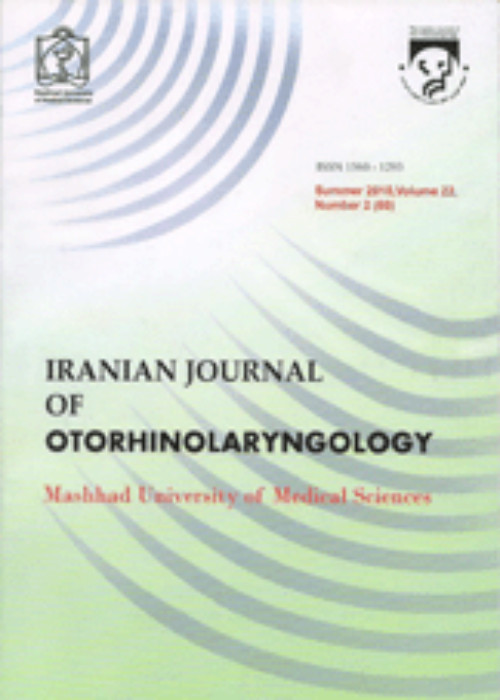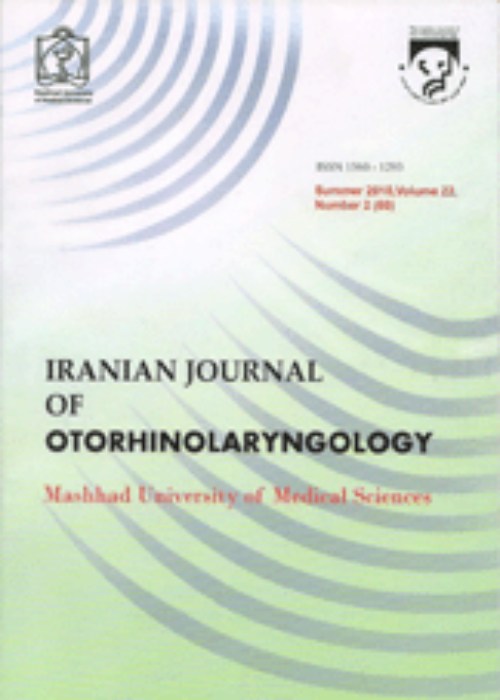فهرست مطالب

Iranian Journal of Otorhinolaryngology
Volume:36 Issue: 1, Jan-Feb 2024
- تاریخ انتشار: 1402/10/11
- تعداد عناوین: 8
-
-
Pages 335-342IntroductionPatient satisfaction with septoturbinoplasty was measured using the subjective visual analogue scale (VAS) and Nasal Obstruction Symptom Evaluation (NOSE) scale. In addition, those factors that impacted satisfaction were confirmed.Materials and MethodsWe conducted an observational study of patients who underwent septoturbinoplasty. Age, sex, smoking habit, duration of improvement, postoperative complications, type of packing and surgeon were analysed. The results were compared using the VAS and NOSE scale.ResultsThe improvement experienced with surgery corresponded to 69.80±26.97 points on the VAS 42.65±22.9 points (p <0.01) on the NOSE scale. A strong, direct correlation between the two scales (r = 0.79; p <0.01) was achieved. Surgeon, presence of complications, smoking habit and type of packing were not associated with the improvement experienced on the VAS or NOSE scale. Patients under 30 years of age and patients with permanent improvement achieved higher levels of satisfaction on both scales (p <0.01). Women showed a stronger tendency to perceive their improvement as temporary (p <0.01).ConclusionsPatients who underwent septoturbinoplasty experienced a subjectively measured improvement in nasal obstruction. The VAS and the NOSE scale were strongly correlated with one another. Sex, age and duration of improvement (temporary versus permanent) impacted patient perception; surgeon, smoking habit and type of packing did not.Keywords: Airway obstruction, Nasal obstruction, Nasal septum, visual analogue scale
-
Pages 343-348Introduction
Hypocalcemia is a common complication of total thyroidectomy (TT). This study was designed to investigate the effect of preoperative vitamin.D (Vit.D) status on the occurrence of post-total thyroidectomy hypocalcemia.
Materials and MethodsPatients who underwent TT without parathyroidectomy were divided into three groups based on their preoperative Serum Vit.D levels (<20 ng/ml, 20-30 ng/ml, and ≥30 ng/ml were considered deficient, insufficient, and normal Vit.D levels, respectively). Serum levels of calcium and phosphorus were measured before and 24 hours after surgery in all patients. The patients were examined for clinical symptoms and signs of hypocalcemia postoperatively. In cases with positive clinical symptoms and signs of hypocalcemia and/or calcium levels <8 mg/dl, PTH level was measured before starting calcium infusion, while serum calcium and phosphorus levels were also measured 24 hours later.
ResultsAmong 100 patients enrolled in this study, 81% were females. The mean age was 36.60±8.32 years. Before surgery, the mean Vit.D level was 26.9±16.89 ng/ml, while 47% of cases had normal Vit.D level, 32% had insufficient vitamin levels, and 21% had Vit.D deficiency. Twenty-four hours after surgery, the calcium (P=0.356) and phosphorus (P=0.743) levels were not significantly different between the three Vit.D groups. A comparison of postoperative PTH levels between the three Vit.D groups showed no significant difference (P=0.596).
ConclusionsBased on our findings, preoperative serum Vit.D levels did not affect postoperative serum calcium levels.
Keywords: Hypocalcemia, Vitamin.D, Total thyroidectomy -
Pages 349-353IntroductionSince sinonasal polyposis (SNP) has a high recurrence rate after surgery, various studies have investigated the effect of corticosteroid medications to prevent disease recurrence. The present study was designed to compare the effect of three forms of local corticosteroids on preventing SNP recurrence post-operatively.Materials and MethodsThis double-blind, randomized clinical trial study was conducted on 108 patients with SNP who underwent functional endoscopic sinus surgery (FESS). Permuted Block Randomization randomly assigned patients into three groups of 36 people: budesonide spray, betamethasone drop, and budesonide nebulizing suspension groups. One and six months after surgery, the patients were evaluated for recurrence of SNP by nasal endoscopy. SNOT 22 questionnaire was used to assess patients’ subjective improvement rate pre- and post-operatively.ResultsAccording to the scores obtained in the Modified Lund-Kennedy Scoring, budesonide nebulizing suspension showed better effects on preventing the recurrence of sino-nasal polyps after FESS compared with betamethasone nasal drops. The score was significantly lower in the budesonide nebulizing suspension group compared to the betamethasone drop group (P=0.043). There was no statistically significant difference in the scores between the budesonide nebulizing suspension group and the betamethasone spray group (P=0.178). Also, we observed significant improvement in facial fullness in patients who received Budesonide nebulizing suspension.ConclusionsBudesonide nebulizing suspension, compared to betamethasone nasal drops, showed better effects on preventing the recurrence of SNP after FESS.Keywords: Corticosteroids, Paranasal Sinuses, Recurrence
-
Pages 355-360Introduction
Hearing loss (HL) is the most frequent sensory neurodeficiency, affecting a broad spectrum of individuals globally. Within this context, the role of genetic factors takes center stage, particularly in cases of hereditary HL.
Case Report:
Here, we present a nonsyndromic HL (NSHL) case report. The patient is a 21-year-old man with progressive HL. The whole-exome sequencing (WES) demonstrated a novel homozygous missense mutation, c.9908A>C; p.Lys3303Thr, in the proband's exon 61 of the MYO15A gene. Further analysis has revealed that the detected mutation is present in a heterozygous state in the parents.
ConclusionWES analysis in this study revealed a novel mutation in the MYO15A gene. Our data indicates that the MYO15A-p.Lys3303Thr mutation is the likely pathogenic variant associated with NSHL. Additionally, this finding enhances genetic counseling for individuals with NSHL patients, highlighting the value of the WES method in detecting rare genetic variants.
Keywords: Hearing Loss, MYO15A gene, Mutation -
Pages 361-363Introduction
An unusual nasopharyngeal foreign body in a very young child with no clinical symptoms is a rare case presentation.
Case Report:
A nine-month-old child presented with a suspected history of foreign body ingestion without any clue to the parents about the nature of the foreign body. X-ray of the nasopharynx revealed a sharp unusual metallic “Louis Vuitton” shoe logo that the child had accidentally inserted into the nasopharynx via the oral cavity while playing. Foreign body was removed under general anesthesia without complications.
ConclusionX-ray nasopharynx should be included in the examination of a suspected case of foreign body ingestion, as an unusual shape of foreign body can even produce no clinical symptoms but still pose a potential life threat due to its dislodgement into the airway if missed or delayed.
Keywords: Nasopharynx, Foreign body, Unusual, rare -
Pages 365-369Introduction
Sarcoidosis is an idiopathic systemic granulomatous disorder that can affect multiple organs, including rare extrapulmonary sites like the premaxilla. This case report presents a rare occurrence of premaxillary sarcoidosis, a condition scarcely reported in medical literature.
Case Report:
The patient, a 62-year-old male, presented with a progressively enlarging painless swelling on the right cheek over a three-year period. Despite multiple Fine Needle Aspiration Cytology (FNAC) examinations yielding no conclusive diagnosis, a contrast-enhanced computed tomographic (CT) scan revealed an ill-defined lesion in the premaxillary soft tissue. Biopsy and subsequent excision procedures confirmed the presence of non-caseating granulomas with asteroid bodies, indicative of sarcoidosis. With no systemic involvement and complete excision of the disease, further treatment was not necessary.
ConclusionThis case highlights the challenges in diagnosing premaxillary (Extrapulmonary Sarcoidosis) sarcoidosis due to its rarity and resemblance to other dental and maxillofacial conditions and granulomatous lesions. Accurate diagnosis requires a high index of suspicion, multidisciplinary approach, involving clinical assessment, histopathological analysis, and imaging modalities. By deepening our understanding of these uncommon presentations, this report aims to enhance clinical awareness and contribute to improved patient outcomes.
Keywords: Sarcoidosis, Head, Neck Sarcoidosis, Extra-pulmonary sarcoidosis -
Pages 371-375Introduction
Schwannoma, a peculiar benign nerve sheath tumour, is frequently hard to differentiate from other nerve tumours, such as neurofibroma. Around 25%-45% of all schwannomas emerge in the head and neck region, but only 0.1-1.5 % involve laryngeal structure. This tumour is most accurately diagnosed with biopsy via direct laryngoscopy; however, at some points this approach cannot detect a definitive diagnosis due to the surrounding capsule of the tumour and its similar histopathologic finding with other nerve sheath tumour.
Case Report:
Here, a case of 56-year-old female is reported with chief complaints of severe progressive dyspnea and dysphagia. Diagnosis of schwannoma was confirmed on radiological and histopathological examination with certain hurdles. A complete surgical excision via endoscopic approach was done, revealing that the bottom of the mass was attached to the right arytenoid mucosa. The histopathological features showed non-malignant atypical neurofibroma but later confirmed as laryngeal schwannoma from immunohistochemical staining.
ConclusionAlthough schwannoma has an excellent outcome and prognosis when occurring elsewhere in the body, laryngeal involvement is an extremely rare area for this lesion. Complete resection with a patient-customized approach to the lesion is required to avoid relapses and provide good functional results.
Keywords: Laryngeal schwannoma, Transoral approach, surgical management, Tracheostomy -
Pages 377-380Introduction
Ear symptoms of granulomatosis with polyangiitis can range from ear fullness and otalgia to conductive or sensory neural hearing loss and sudden deafness. Cochlear implantation in these patients faces two challenges: access to the round window and control of mastoid and middle ear inflammation. The combined approach in cochlear implantation is a classic trans-facial recess approach facilitated by a trans-canal view.
Case Report:
In this case report, we present the "combined approach" in a 20-year-old lady with granulomatosis with polyangiitis who underwent cochlear implantation successfully using the combined approach.
ConclusionPost-operative results suggest that the “combine approach” seems to be a safe, easy, and fast cochlear implantation technique for chronic otitis media with an atelectatic middle ear and retracted tympanic membrane or narrow facial recess space. It is a single-stage surgery that has no need for the obliteration of the ear and has less morbidity.
Keywords: Cochlear Implants, Otitis media, Sensorineural hearing loss, Cochlear Implantation, Otitis media with effusion


